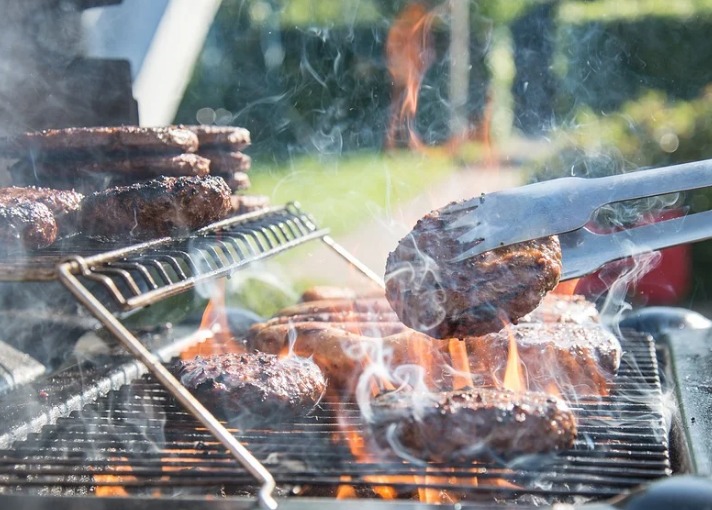
How you cook on a grill depends on the type of food you’re preparing. No matter what you’re cooking, always preheat your grill for five minutes before placing the food on it.
How to Grill Hamburgers

If you’ll be making your own hamburger patties, follow these steps:
- Buying ground beef: Get 80–85% lean ground beef. Leaner beef won’t bind well enough to form patties; fattier beef will drip into the fire and cause flare-ups.
- Making patties: Form equal-sized patties, and don’t mix the ground beef too much—doing so will make the meat tough.
- Cooking the burgers: Cook over a medium fire (about 350°F). Turn once halfway through the cooking time.
- Cooking time: The cooking time depends on the thickness of the burger and how you like it cooked.
|
Thickness
|
Rare (min/side)
|
Medium (min/side)
|
Well Done (min/side)
|
|||
|
1/2″
|
2–3
|
3–5
|
5–7
|
|||
|
3/4″
|
3–4
|
5–7
|
7–9
|
|||
|
1″
|
4–5
|
6–8
|
8–10
|
How to Grill Hot Dogs
Hot dogs are sold precooked, so they only need to be grilled long enough to brown the exterior and warm the interior. Cook your hot dogs over medium heat for 7–8 minutes, turning frequently so that all sides brown evenly.
How to Grill Chicken
Because chicken is fairly dense, it benefits from marinating. Grilling chicken can be difficult, since different parts cook at different rates, and pieces can vary in size and thickness. To cook an average boneless, skinless 6-oz chicken breast:
- Place the breast on a medium-hot grill and let it cook, covered, for 8–15 minutes. Turn the chicken when the edges begin to turn white.
- Turn the breast over, place the lid on the grill, and cook for another 8–15 minutes or until an instant-read thermometer inserted into its center reads 160°F.
- Remove the breast and let it sit for a few minutes before serving.
As a general rule, breasts cook faster by weight than thighs and legs, and boneless pieces cook faster than bone-in pieces. If you’re cooking anything other than boneless breasts, add 2–3 minutes to steps 1 and 2. Chicken cooked properly should be white inside with no pink coloring.
How to Grill Steaks
Tender cuts of beef, such as T-bones, sirloins, tenderloins, ribeyes, and porterhouses, do not need to be marinated, whereas tougher cuts, such as skirts, flanks, rounds, and chuck steaks, benefit from overnight marinating. Cooking time depends on the thickness of the steak and how you want it cooked.
|
Thickness
|
Rare (min/side)
|
Medium (min/side)
|
Well Done (min/side)
|
|||
|
1/2″
|
2–3
|
3–5
|
5–7
|
|||
|
3/4″
|
3–4
|
5–7
|
7–9
|
|||
|
1″
|
4–5
|
6–8
|
8–10
|
How to Grill Vegetables

The vegetables best-suited to grilling are peppers, onions, corn, eggplant, tomatoes, potatoes, asparagus, portobello mushrooms, and squash. The simplest and most common method for grilling vegetables is the following:
- Brush the vegetables with oil and season as desired.
- Grill until the vegetables soften and change color, switching sides every 3–4 minutes. Total cooking time depends on the type and thickness of the vegetable.
With the exception of corn and asparagus, most vegetables should be sliced so they lie flat on the grill grates and don’t fall through the cracks. Vegetables benefit from marinating, but they should not sit in a marinade for longer than one hour. Marinated vegetables do not need to be brushed with oil before grilling.
How to Grill Fish

Both fish steaks and fillets are excellent for grilling. If you’ve never grilled fish before, begin with fish steaks—they’re firmer and less likely to fall apart than delicate fillets. The steaks should be 1″ to 1 1/2″ thick. To grill fish steaks:
- Season the steaks.
- Place the steaks over a medium‑hot fire.
- Grill for about 8 minutes, turning once halfway through.
- Check for doneness by placing a thin knife between flesh layers. If the flesh is opaque, the fish is ready to come off the grill.
Fillets of firm-fleshed fish, such as salmon, halibut, and swordfish, can be grilled just like steaks. Flakier fish fillets, such as bluefish, trout, and catfish, are better grilled in a fish basket, two grates connected by a hinge that pulls the grates against both sides of a fillet to keep it from falling apart as it’s grilled.
How to Determine Doneness of Meats
If you’re an experienced griller, you can test the doneness of a piece of meat by eye or by prodding the meat to check its firmness. If you’re inexperienced, use an instant-read thermometer. To use this type of thermometer, pierce the flesh of your food with the tip of the probe and insert it into the center of the meat. Don’t let the probe touch any bones—this will give you a false reading.
|
Type of Meat
|
Final Temperature
|
|
|
Beef
(steaks, roasts, tenderloins)
|
Medium rare: 140°F
Medium: 150°F
Well done: 160°F
|
|
|
Hamburgers
|
Medium rare: 145°F
Medium: 155°F
Well done: 165°F
|
|
|
Fish
|
140°F
|
|
|
Ground turkey
|
170°F
|
|
|
Pork
(chops, roast, tenderloin)
|
155°F
|
|
|
Pork sausage
|
160°F
|
|
|
Poultry
|
165°F
|
|
|
Lamb (leg, roast)
|
Medium rare: 145°F
Medium: 155°F
Well done: 165°F
|
Even after you take meats off the grill, they continue to cook and their temperatures go up 5–10°F. As a result, always remove items from the grill when your thermometer reads 5–10°F below the final temperatures listed above.

